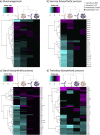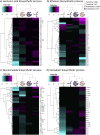Comparative Plant Transcriptome Profiling of Arabidopsis thaliana Col-0 and Camelina sativa var. Celine Infested with Myzus persicae Aphids Acquiring Circulative and Noncirculative Viruses Reveals Virus- and Plant-Specific Alterations Relevant to Aphid Feeding Behavior and Transmission
- PMID: 35856906
- PMCID: PMC9430646
- DOI: 10.1128/spectrum.00136-22
Comparative Plant Transcriptome Profiling of Arabidopsis thaliana Col-0 and Camelina sativa var. Celine Infested with Myzus persicae Aphids Acquiring Circulative and Noncirculative Viruses Reveals Virus- and Plant-Specific Alterations Relevant to Aphid Feeding Behavior and Transmission
Erratum in
-
Erratum for Chesnais et al., "Comparative Plant Transcriptome Profiling of Arabidopsis thaliana Col-0 and Camelina sativa var. Celine Infested with Myzus persicae Aphids Acquiring Circulative and Noncirculative Viruses Reveals Virus- and Plant-Specific Alterations Relevant to Aphid Feeding Behavior and Transmission".Microbiol Spectr. 2024 Oct 3;12(10):e0192424. doi: 10.1128/spectrum.01924-24. Epub 2024 Sep 11. Microbiol Spectr. 2024. PMID: 39258925 Free PMC article. No abstract available.
Abstract
Evidence is accumulating that plant viruses alter host plant traits in ways that modify their insect vectors' behavior. These alterations often enhance virus transmission, which has led to the hypothesis that these effects are manipulations caused by viral adaptation. However, we lack a mechanistic understanding of the genetic basis of these indirect, plant-mediated effects on vectors, their dependence on the plant host, and their relation to the mode of virus transmission. Transcriptome profiling of Arabidopsis thaliana and Camelina sativa plants infected with turnip yellows virus (TuYV) or cauliflower mosaic virus (CaMV) and infested with the common aphid vector Myzus persicae revealed strong virus- and host-specific differences in gene expression patterns. CaMV infection caused more severe effects on the phenotype of both plant hosts than did TuYV infection, and the severity of symptoms correlated strongly with the proportion of differentially expressed genes, especially photosynthesis genes. Accordingly, CaMV infection modified aphid behavior and fecundity more strongly than did infection with TuYV. Overall, infection with CaMV, relying on the noncirculative transmission mode, tends to have effects on metabolic pathways, with strong potential implications for insect vector-plant host interactions (e.g., photosynthesis, jasmonic acid, ethylene, and glucosinolate biosynthetic processes), while TuYV, using the circulative transmission mode, alters these pathways only weakly. These virus-induced deregulations of genes that are related to plant physiology and defense responses might impact both aphid probing and feeding behavior on infected host plants, with potentially distinct effects on virus transmission. IMPORTANCE Plant viruses change the phenotype of their plant hosts. Some of the changes impact interactions of the plant with insects that feed on the plants and transmit these viruses. These modifications may result in better virus transmission. We examine here the transcriptomes of two plant species infected with two viruses with different transmission modes to work out whether there are plant species-specific and transmission mode-specific transcriptome changes. Our results show that both are the case.
Keywords: RNA-seq; aphid vector; caulimovirus; feeding behavior; insect-plant interactions; plant viruses; polerovirus; transcriptome profiling; transmission.
Conflict of interest statement
The authors declare no conflict of interest.
Figures










Similar articles
-
Erratum for Chesnais et al., "Comparative Plant Transcriptome Profiling of Arabidopsis thaliana Col-0 and Camelina sativa var. Celine Infested with Myzus persicae Aphids Acquiring Circulative and Noncirculative Viruses Reveals Virus- and Plant-Specific Alterations Relevant to Aphid Feeding Behavior and Transmission".Microbiol Spectr. 2024 Oct 3;12(10):e0192424. doi: 10.1128/spectrum.01924-24. Epub 2024 Sep 11. Microbiol Spectr. 2024. PMID: 39258925 Free PMC article. No abstract available.
-
Plant infection by two different viruses induce contrasting changes of vectors fitness and behavior.Insect Sci. 2019 Feb;26(1):86-96. doi: 10.1111/1744-7917.12508. Epub 2017 Aug 30. Insect Sci. 2019. PMID: 28731285
-
An Aphid-Transmitted Virus Reduces the Host Plant Response to Its Vector to Promote Its Transmission.Phytopathology. 2023 Sep;113(9):1745-1760. doi: 10.1094/PHYTO-12-22-0454-FI. Epub 2023 Oct 26. Phytopathology. 2023. PMID: 37885045
-
Modelling and manipulation of aphid-mediated spread of non-persistently transmitted viruses.Virus Res. 2020 Feb;277:197845. doi: 10.1016/j.virusres.2019.197845. Epub 2019 Dec 23. Virus Res. 2020. PMID: 31874210 Free PMC article. Review.
-
Insect transmission of plant viruses: Multilayered interactions optimize viral propagation.Insect Sci. 2017 Dec;24(6):929-946. doi: 10.1111/1744-7917.12470. Epub 2017 Jul 18. Insect Sci. 2017. PMID: 28426155 Review.
Cited by
-
Variability of plant transcriptomic responses under stress acclimation: a review from high throughput studies.Acta Biochim Pol. 2024 Oct 25;71:13585. doi: 10.3389/abp.2024.13585. eCollection 2024. Acta Biochim Pol. 2024. PMID: 39524930 Free PMC article. Review.
-
Facilitation of Sclerotinia sclerotiorum infestation by aphid feeding behaviour is not affected by aphid resistance in oilseed rape.Heliyon. 2024 Jun 6;10(11):e32429. doi: 10.1016/j.heliyon.2024.e32429. eCollection 2024 Jun 15. Heliyon. 2024. PMID: 38933983 Free PMC article.
-
Small Talk: On the Possible Role of Trans-Kingdom Small RNAs during Plant-Virus-Vector Tritrophic Communication.Plants (Basel). 2023 Mar 22;12(6):1411. doi: 10.3390/plants12061411. Plants (Basel). 2023. PMID: 36987098 Free PMC article. Review.
-
Cauliflower mosaic virus disease spectrum uncovers novel susceptibility factor NCED9 in Arabidopsis thaliana.J Exp Bot. 2023 Aug 17;74(15):4751-4764. doi: 10.1093/jxb/erad204. J Exp Bot. 2023. PMID: 37249342 Free PMC article.
-
Deep Sequencing Analysis of Virome Components, Viral Gene Expression and Antiviral RNAi Responses in Myzus persicae Aphids.Int J Mol Sci. 2024 Dec 8;25(23):13199. doi: 10.3390/ijms252313199. Int J Mol Sci. 2024. PMID: 39684909 Free PMC article.
References
-
- Fereres A, Raccah B. 2015. Plant virus transmission by insects, p 1–12. In eLS. John Wiley & Sons, Ltd, Chichester, UK. doi:10.1002/9780470015902.a0000760.pub3. - DOI
Publication types
MeSH terms
LinkOut - more resources
Full Text Sources

